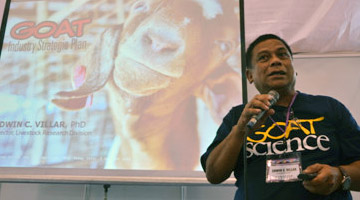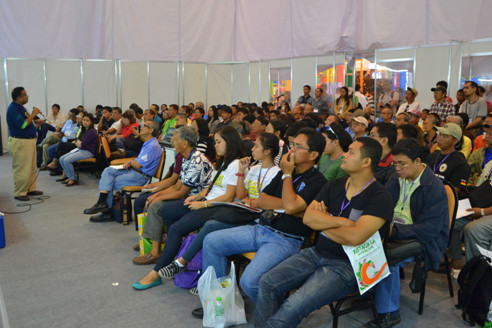 “The ISPs describe the targets for each industry and pinpoint the aspects of the industry where S&T will make a difference”.
“The ISPs describe the targets for each industry and pinpoint the aspects of the industry where S&T will make a difference”.
This, the Philippine Council for Agriculture, Aquatic and Natural Resources Research and Development (PCAARRD) Livestock Research Division Edwin C. Villar said as he presented the Council’s 2020 Industry Strategic Plan (ISP) for Goat at the 2012 Agrilink held recently at the World Trade Center in Pasay City.
“ISP is about partnership with government and the industry and where science can make a dent in the goat industry”, Villar explained. Moreover, the ISP is PCAARRD's contribution in shaping and forging desired societal outcomes.
Currently, the goat industry faces poor productivity (dam performance, slow growth of kids, and high pre-weaning mortality), slow population growth rate, and too high extraction rate (108% goat slaughtered in 2010). In relation to these, Dr. Villar stressed the industry players’ concern is on increasing income through improvements on productivity.
PCAARRD’s ISP for goat envisions increase in goat population (up to 6.2 million), conception rate (from 75% to 90%), and slaughter weight (from 15 kg to 30 kg), while there will be decrease in kidding interval (from 9 months to 8 months) and pre-weaning mortality (from 25% to 10%) by 2020.
To achieve these goals, PCAARRD has put on ground its banner programs, particularly the initiatives on strategic research and development (R&D), technology transfer, policy analysis and advocacy, and capability building for the goat industry.
Strategic R&D includes development of improved health and feeding protocols that can increase kid survival and enhancement of breeding protocols to improve slaughter weight.
Through PCAARRD’s 2006─2010 Science and Technology (S&T) Agenda, artificial insemination (AI) practices in goats have improved through the development of powder semen extender and AI delivery system.
Moreover, farm recording system (FRS) at the backyard level was developed to monitor gains and losses incurred and consequentially, to analyze profit.
Villar explained further that the new S&T direction for the goat industry includes enhancement of the FRS and development of product traceability. He pointed out that to widen cooperation, collaboration with research agencies in regions 1, 2, 3, 8, 10, and 12 shall be done.
In addition, a Halal Assurance System (HAS) to authenticate Halal protocols for goat-based products, slaughtering/cutting standardization, and product diversification will be established.
 “In terms of R&D, we want to address strategic aims for development”, Villar asserted. He also underscored the importance of technology accessibility.
“In terms of R&D, we want to address strategic aims for development”, Villar asserted. He also underscored the importance of technology accessibility.
Thus technologies to be transferred to the countryside will include promotion of pelletized total mixed rations, AI delivery system (AI-DS) and FRS, Community based- Science and Technology-based Farm (STBF) on chevon production, and TechnoMart Project on goat-based products.
STBF in the past years has chosen progressive farmers who are willing to demonstrate the benefits of using S&T interventions to other potential farmer adopters.
“But now, we want the whole community to adopt a certain intervention to produce the primary product to meet the demand of the market”, he said.
In tandem with research is the development of enabling policy. According to him, the Bureau of Animal Industry has recognized the FRS PCAARRD has previously developed.
The ISP, however, will include development of policy instruments on goat AI-DS that can form part of the unified AI program, FRS, HAS, and chevon cutting and slaughtering standards.
Capability building will involve enhancement of an animal health laboratory and chevon processing center and global technology search/training on cryobiology for AI and Halal chevon production, processing, and marketing.
Dr. Villar also presented the expected improvement in 2020 through the implementation of the new ISP in terms of the volume of production.
With S&T, volume of production is expected to have an additional 57.35 thousand metric tons by 2020.
